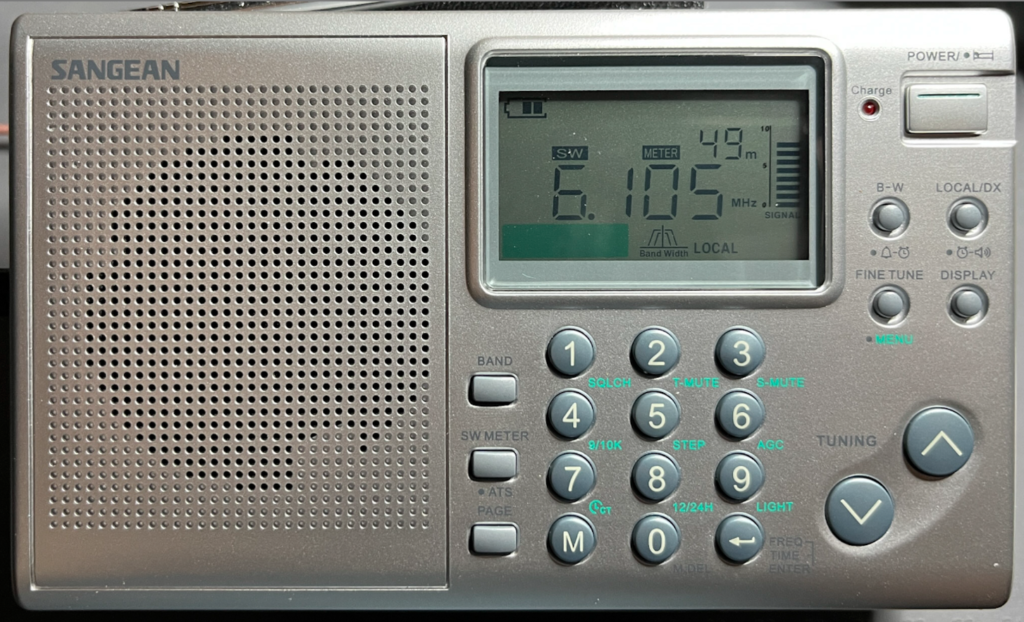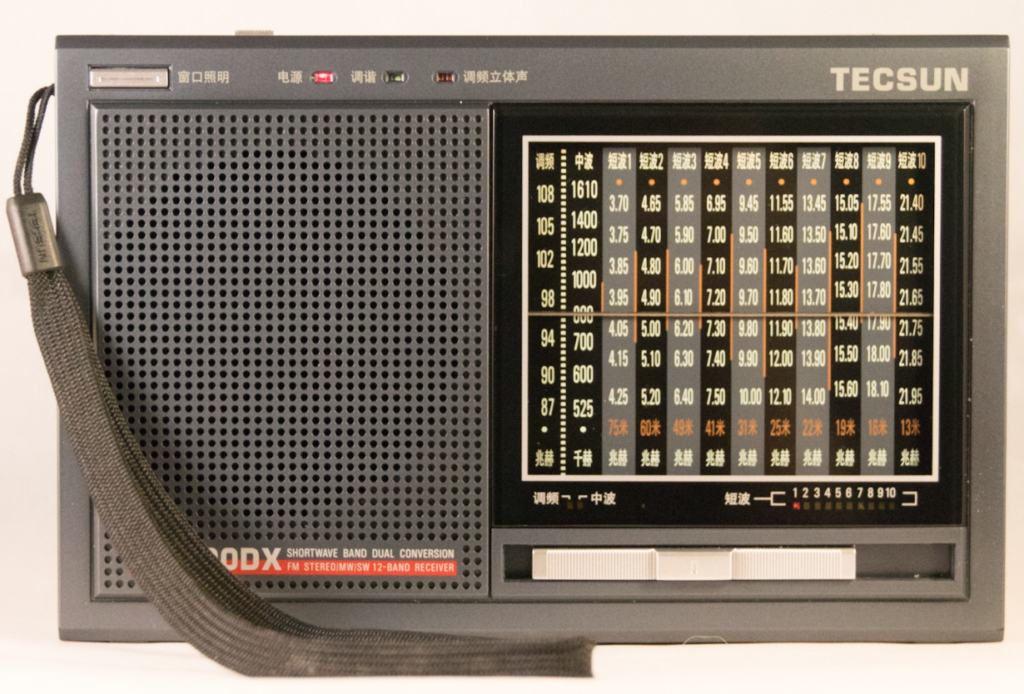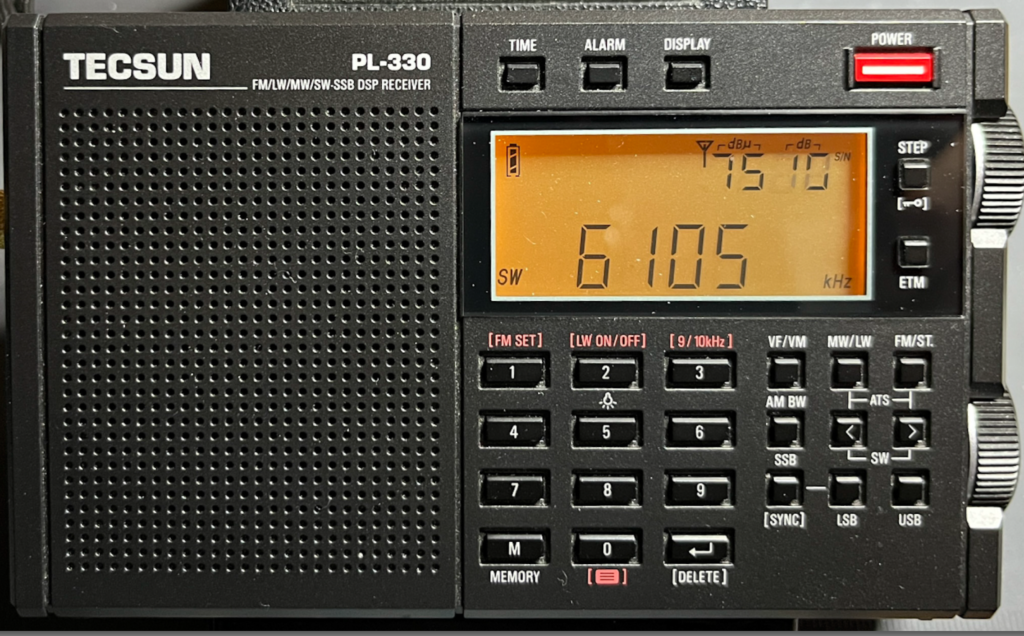After the roaring success of my Battle of the under $50 shortwave radios (36 views! ROFL) I’m inspired to up the ante and review models that could be purchased today with shipping between $50 and $100. The contestants this time are definitely more interesting:
- Sangean ATS-405
- Tecsun PL-330
- Tecsun R-9700DX
- XHDATA D-808
Zhiwhis ZWS-A320 (aka Raddy RF320, HanRongDa HRD-A320, Retekess TR112)
The R-9700DX is about $55 with shipping from Kaito USA on eBay. The PL-330 is around $80 on Amazon. The ATS-405 can be found on Amazon for $73; its price varies. The XHDATA D-808 has become popular with shortwave listeners and it’s price has shot up about 30% in the last 5 months. It can still be purchased direct from the XHDATA website for slightly under $100.
Breaking news! The ZWS-A320 was defective; the antenna joints were frozen together in two places. I returned it and reordered. The second one’s antenna joints were frozen together in one place. I returned it. I’ve given up on this radio. ZHIWHIS customer support says that I’m the only one reporting the problem. (What are the odds?)
More news! This article was originally published in 2023 before a very important entrant appeared on the US market, the Qodosen DX-286. These articles are points in time, but sometimes things are important enough to go back and update the record.
Overview
DX-286

The DX-286 is a new design based on the TEF 8688 chip primarily used in automotive radios. It performs at a high level in all categories, but perhaps outstrips any portable using an antenna and ground on LW and MW. It supports the antenna jack on these bands. (The DX-286 is essentially the same as the SR-286.)
R-9700DX
The Tecsun R-9700DX is a pure analog radio, a dual-conversion superheterodyne model. It’s quite straightforward, with little in the way of features beyond a dial light, an external antenna jack and a tuning LED. It has a slide rule dial to cover MW, FM and 10 shortwave bands. The radio only covers select international broadcast frequencies and tops out at 1620 on MW. Mine has Chinese language labels.
Sangean ATS-405
The Sangean ATS-405 is an MW/FM/SW receiver that uses a digital signal processing (DSP) chip for tuning and signal demodulation. All of the radios in this battle, with the exception of the Tecsun R-9700DX, are the same. The ATS-405 has a very easy to read display, and sports the usual features of a DSP radio, direct frequency entry, station preset memory, variable bandwidth, digital frequency display, and a clock/alarm/sleep timer.

Tecsun PL-330
The Tecsun PL-330 is the most compact of the group. It adds longwave, single sideband detection (SSB), synchronous tuning, and auto tune storage (ATS) on shortwave. It is a general coverage shortwave receiver spanning 1711 to 29999 kHz.
XHDATA D-808
The XHDATA D-808 adds more features to the table with FM RDS and AIR band. This radio radio has created a great deal of interest in the shortwave listening community with good reason. It’s the serious competitor to the Tecsun PL-330.

Let’s make a table!
| Feature | ATS-405 | DX-286 | R-9700DX | PL-330 | D-808 |
|---|---|---|---|---|---|
| Price | $73 | $79 | $55 | $80 | $98 |
| Tech | DSP | DSP | Analog | DSP | DSP |
| SW Freq. | 2.3 to 26.1 | 1.7 to 27000 | 3.9 to 21.851 | 1.7 to 29.999 | 1.7 to 29.999 |
| LW | Y | Y | Y | ||
| Air | Y | ||||
| MW Sens. | n/s | ≤ 10μv | < 1mV/m | <1mV/m | 0.5mV/m |
| SW Sens. | n/s | ≤ 10μv | < 30μV | <20μV | <10μV |
| FM Sens. | n/s | ≤ 0.5μv | < 10μV | <3μV | <3μV |
| FM RDS | Y | Y | |||
| Bandwidth set | 3 | Multi | n/a | Multi | Multi |
| Speaker | 0.7W | 3W | 0.25W | 0.5W | 1W |
| Tone control | Y | Y | Y | ||
| Presets | 108 | 1000 | n/a | 9650 | 500 |
| SSB | Y | Y | |||
| Sync tune | Y | ||||
| Antenna Jack | Y | Y | Y1 | Y | |
| Antenna Length (in.) | 28 1/4 | 18.5 | 33 | 19 | 25 1/2 |
| Local/DX | Y | Y | Y | Y | |
| Battery | 4 AA | 18650 | 4 AA | BL-5C | 18650 |
| Charge | 7.5V | USB Micro | 6V | USB Micro | USB C |
1 The R-9700DX has 10 SW bands, broadcast bands only. It is not general coverage. The bands are: 3.90 – 4.00, 4.75 – 5.06, 5.95 – 6.20, 7.10 – 7.30, 9.50 – 9.90, 11.65 – 12.05, 13.60 – 13.80, 15.10 – 15.60, 17.55 – 17.90, 21.45 – 21.85 MHz.
2 The external antenna jack on the PL-330 can be used on MW through a “hidden feature.”
Observations
While the PL-330 is the only radio without a Local/DX setting, it is also the radio that seems least affected by overloading. The Qodosen DX-286 has a variable attenuator setting and the ability to turn off a front end low noise amplifier (LNA).
The DX-286 is the loudest of the group with perhaps the PL-330 in second place and others not all that loud. Other less expensive radios have 3W speakers. It’s a puzzle.
Opening Opinions
Going into the comparison, I’ll share some opinions (that might be challenged later?). The first is that the PL-330, DX-286 and the D-808 are the only radios in the group a serious shortwave listener would consider. They are general coverage receivers that cover LW and the entire SW band. Only the PL-330 and D-808 have SSB detection. Only the PL-330 has synchronous detection, and only the D-808 has air band. The PL-330 has a shorter antenna and is easier to carry; the D-808 has a better speaker. I’ll always pick the PL-330 when traveling because it’s lightweight, compact, full featured and has superior band scanning capability. I’ve compared it to the D-808 before: PL-330 or D-808?
I’ve been unimpressed with the R-9700DX because it’s difficult to read frequencies from its dial, and the dial on mine isn’t particularly accurate. Despite its technology that should give a lower noise floor, I get fewer, not more stations on it. It also overloads with an external antenna and has images. The speaker is big and folks like the nostalgic dial light.
The Sangean ATS-405 is a great MW receiver, but less sensitive on shortwave with the telescopic antenna. The display is easy to read in any light and it provides many settings like squelch, soft mute, and tuning mute; however, direct frequency entry is clumsy, preset memory is limited, and there is no ATS on shortwave. The speaker can’t be turned up loud. Of course, as with any radio, one can always clip on an external antenna.
This website already has reviews and comparisons all 5 radios, and covers them about as well as I can. The DX-286 is the top performer, followed by the PL-330 and the D-808. The ATS-405 comes in the second tier with a nice implementation and slightly lower sensitivity. The R-9700DX is just not a radio I work up any enthusiasm for; the inaccurate dial is a deal breaker for me; still, many others like it.
There are a couple of things to mention that don’t directly relate to performance. One very annoying thing about the PL-330 is that it does not have a kickstand. At home I have a stand I use with it, but away from home the lack of a stand is very inconvenient. There is a disparity in the cases that come with the radios. The ATS-405 has the all-around best case; it’s a pouch with a fold over flap secured by Velcro; it’s easy to insert the radio into it and easy to close securely. The R-9700DX has an attractive case, but it doesn’t fit very well; it’s difficult to wedge the radio into a narrow opening at the bottom of the fold-over case, and the fold over is a little too short to comfortably enclose the radio. The PL-330 and D-808 both come with string-closed bags that are a little clumsy to use. The DX-286 has a foam-lined hard shell case and an optional fold over Velcro case similar to the ATS-405.
Radio performance comparisons
All my radio comparisons start out with the daytime AM/FM band scan. These are done at midday outdoors with the radio oriented in a southeast direction (for MW) and with the telescopic antenna for FM.
The surprise here is the poor MW performance of the larger Tecsun R-9700DX. It could have been better based on its size and technology. My similarly-sized vintage Panasonic RF-085 gets 4 times as many MW stations. Also, the R-9700DX does not receive the upper portion of the North American MW band, from 1620 – 1710 kHz. The Sangean and Qodosen are on top for MW. R-9700DX is poor on FM compared to the others.
In all of my shortwave testing, the ATS-405 has lagged behind the PL-330 and the D-808 in sensitivity. When I attempted to receive the weak Music 4 Joy transmission with a clip-on antenna, the ATS-405 just didn’t get it when the others could (the R-9700DX barely). On a later session with a stronger signal, I was able to receive the station on all 4 radios fairly well. (The DX-286 wasn’t around to participate in that test.)
I’d typically like to compare radios receiving time stations WWV or CHU, but the R-9700DX doesn’t cover any WWV or CHU frequency.
Only two of the radios can process SSB signals, the PL-330 and the D-808. Samples and comparisons for those can be found in my article: SSB! Four of the radios have any sort of a memory preset system. The ATS-405 has only 36 memory presets for each band, 108 memories total, and no automatic storage for shortwave. With only 36 shortwave presets, ATS doesn’t make much sense. The D-808 is better with 100 for each band, but they are awkwardly arranged in 10 pages of 10 presets each and there’s no way to scroll through them. The PL-330 has a nearly perfect memory system. Check out my Radio memory systems article for details.
(The DX-286 wasn’t around for this test but it does get CFRX well.) I decided to try a new location to test radios. I like station CFRX in Toronto on 6070 MHz, but unfortunately RF interference where I live is severe around that frequency. I found a picnic table next to a tennis court within walking distance and decided it to give it a whirl. I first tested the radios using a Sangean AN-06 reel antenna attached to a tree limb, but that proved just too easy for these radios, so I changed tack and switched to their telescopic antennas. As shown in the earlier specifications table, the R-9700DX has the longest antenna, followed by the ATS-405, D-808 and the PL-330 in descending order; however reception did not follow that order. I observed pretty much what I expected to observe: the ATS-405 had the best audio system, but the least sensitivity. The R-9700DX worked OK, but it was difficult to tune and it drifted. The D-808 received well but couldn’t be turned up loud. The PL-330 speaker could be turned up louder.
I have each radio recorded multiple times and the listener may note that conditions varied over time. This was particularly noticeable with the ATS-405. Any humming noise you may hear is environmental and not from the radios.
How do they sound?
The video below is recorded, as are most all of my radio videos, using an iPhone 13. I personally think the microphone on this device records a good representation of how the radios sound. As radios go, these aren’t particularly loud.
The video following is of a strong signal from WWCR in Nashville, Tennessee, via MLA-30+ antenna, playing pop songs. I threw in a sample at the end from an Eton Elite Executive that was handy, for the purpose of demonstrating what a more expensive radio could do.
The D-808 speaker power rating is higher then the PL-330, but the latter can be turned up louder. Sometimes the D-808 is just lacking in volume. The ATS-405 seemed to have better bass response than the others.
Summing Up
Some are more sensitive, some easier to tune, some have extra features and some have a nicer speaker. Different people would come up with different answers. I personally like the Qodosen DX-286 and Tecsun PL-330 best and that’s why they’re in my upstairs radio collection, and the others are downstairs. [Update: the D-808 has moved upstairs.]
Reference
Here are other other articles covering these radios in some detail:
- PL-330 or D-808?
- Radio of the week: Sangean ATS-405
- Radio memory systems
- SSB!
- Tecsun R-9700DX Radio Compared
- Qodosen DX-286
Update
It’s now October of 2025 and there are other options for consideration. The reader may want to check out my articles on these:



Hello, Kevin. Thank you for this. Country of manufacturing origin is important to me, i.e. especially nothing from Communist China. I suppose that will be difficult to find. What do you know of country of origin for these radio receivers?
May God guide and bless you all the way home to Jesus.
~~~Miles
To the best of my knowledge, all of the radios listed in this post are made in China, and in fact pretty much any portable shortwave made today comes from China, the exception being some SDRs.
Otherwise you’re looking for a vintage radio. I recently purchased a vintage Sangean ATS-909 (not X or X2) and it states on the case that it was made in Taiwan, about 21 years ago. It was under $100 on eBay and is a very good radio (early models have speakers that went bad but mine is fine).
Thank you for these posts, they have helped me take a decision for my first shortwave radio.
I’ve owned three of these radios (D-808, PL-330 and R-9700DX).
The PL-330 was the first I bought on my return to the SW listening hobby, I was quite impressed with it until the display died suddenly after a couple of weeks so I returned it. The soft muting while tuning annoyed me (I like to browse manually rather than scan) so I didn’t ask for a replacement. I spent a bit more money and bought a Tecsun PL-880 instead and instantly fell in love with it.
After seeing all the good reviews for the D-808 I was intrigued so I bought one. Its performance lived up to the hype but once again the soft muting drove me nuts. I tried using the scan function instead but the way it stores stations is just crazy and too hard to use so I sold it.
I bought the R-9700DX on a whim as I wanted to try an analogue radio. It’s a decent performer but as you mention the inaccurate dial lets it down and the stiff tuning wheel does not help – I read a comment on a YT video that someone managed to loosen it up a bit by fiddling with the spring inside, I might take it apart one day and see if I can improve the feel. Also the sliding band selector has a lot of play and feels a bit janky. But in spite of these things it will stay in my collection. I like the sound from the larger speaker.
I recently bought a Tecsun PL-680 after seeing some good reviews and it is very impressive, it’s comparable to the PL-880. I find myself alternating between the two as my daily drivers.
I’ve also been buying a few under $50 radios just for giggles (can one own too many radios? My collection is up to ten now.). They are fun to play with but I really have to stop buying more. I find each radio has its quirks and personality, it’s all part of the fun. Thanks for your reviews, been having fun this morning browsing your site.
Serious question, why not just get up baofeng radio?
I’m not a ham radio operator.